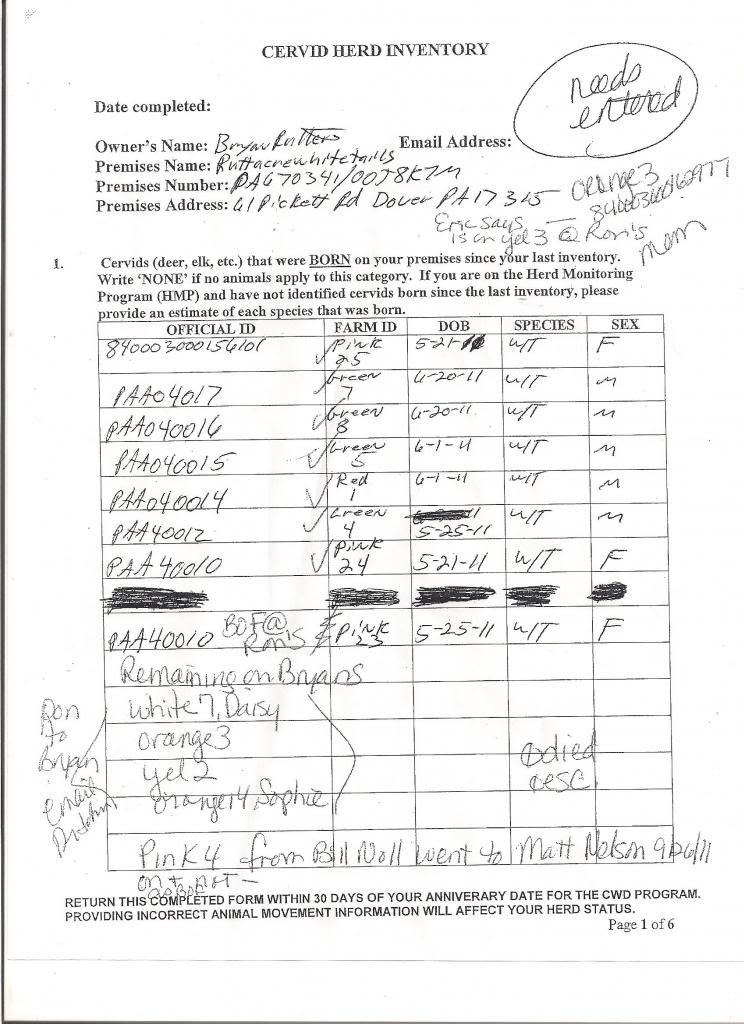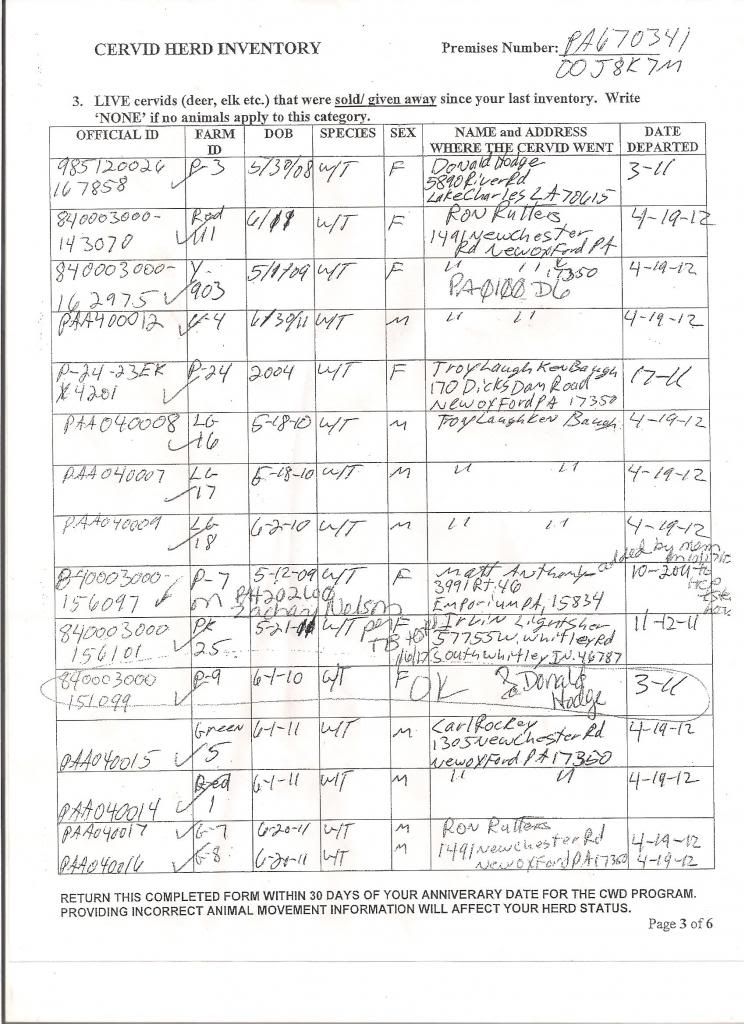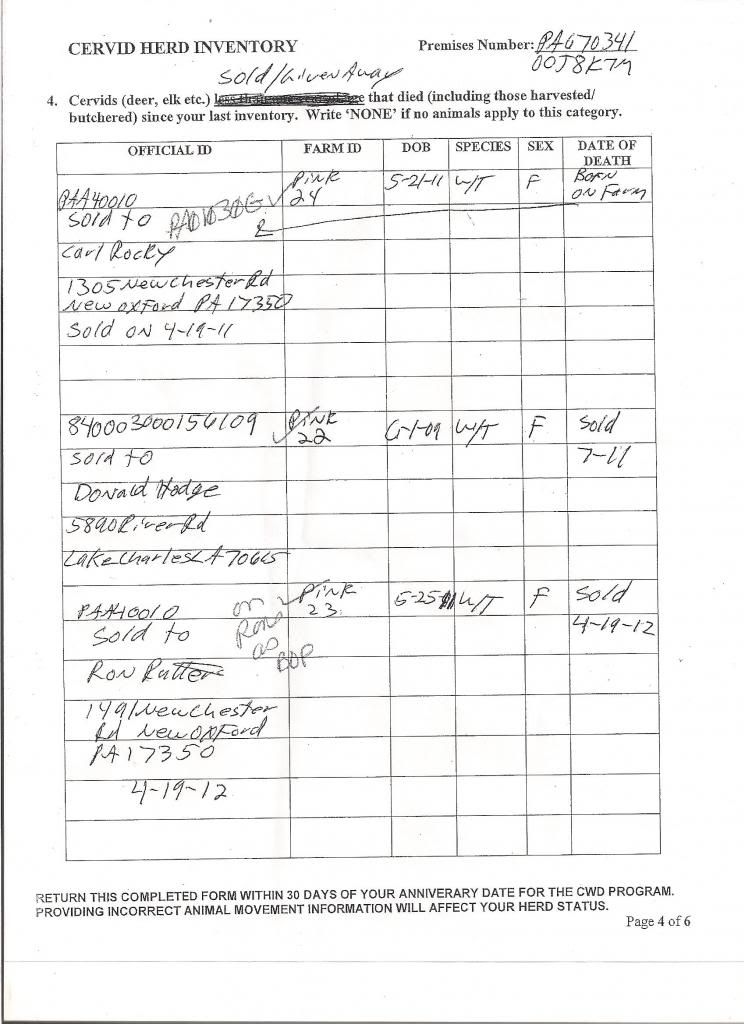Post by Deleted on Mar 21, 2013 7:01:47 GMT -5
I made the trip to Roaring Spring last evening for a really well designed presentation. The highlight of the evening was Walt Cotrell (SP?) the PGC veterinarian who gave a great presentation on exactly what a prion disease is and how it kills deer. He worked the crowd like an old pro, answering questions as they came up. This old classroom teacher/guest speaker was impressed and that is not easy for someone to do. If I missed a few important things or misquoted Walt, please accept my apologies. It was a long meeting and I may have missed a few important things. I'm human. Some facts he presented follow.
CWD is not curable and is 100% fatal if a deer contracts it.
There is no cure, no vaccine, and there are no medicines for it.
It originated in captive mule deer populations in Wyoming and Colorado in the 1960s, and is believed to be a mutation of Scrapie, a disease of sheep also caused by a prion.
Prions were first described as "retroviruses," but they have neither DNA nor RNA, so they are not really viruses but are a sort of protein. A chain of amino acids that can effect normal proteins in the brain. The brain cells thus effected die, and then the body's normal housekeeping processes remove the dead cells leaving holes in the structure of the brain resembling a sponge under microscopic exam. Thus the term "spongiform encephalopathy."
It can only be detected by doing sectioning and staining of tissue taken from the nervous system or lymphatic system of dead deer. The brain stem and lymph nodes close to the brain are harvested and sectioned, and then stained to show the effects of the prion.
Using this technique, the PGC has tested over 42,000 deer carcasses in the past years and this year. The three deer found to be positive in wild populations all came from WMU 4A; two in Blair County and one from Bedford County.
The disease is spread by contact with an infected deer (body fluids such as saliva), by eating contaminated soil. It is also spread via feces and urine.
There is no evidence that CWD currently effects species other than Cervids (elk, deer, moose), but it may experimentally be induced by injecting the prion into the brain of a few others. There has never been any indication that it is transmissable to man. Flounder may have a different view of this.
CWD is more prevalent in male deer than in females.
It is tested for by visiting butcher shops and taking tissue samples and also by taking samples from roadkilled deer. Hunter harvests will be a big source in 4A in the disease management area, which is bounded on the west by the Alleghenny Mountain, on the north by Rt. 22, on the east by the Juniata River (Raystown Branch) and Raystown Lake, and on the south by Route 30. These are tentative boundaries and may be subject to change.
A map was distributed showing where the three deer that tested positive in the study area were taken. No definitive reason was given for the existence of these cases, but a positive sample from Maryland was found about 20 miles south of this area and of course the cases in York County were about 50 miles from there. It was not mentioned at the meeting, but as posted on these boards, deer from the York County farm were transported to a farm in Blair County, and some may have escaped.
Walt stated that there are two possible ways for the disease to have come here; it walked across our border, or it came by truck. It could have been brought here via a mule deer or whitetail trophy brought home by a successful hunter from an area that has CWD or by shipment of a live deer to a deer farm (my opinion is that this is the most likely scenario).
A question was asked of Walt as to how food plots and corn piles are different in concentrating deer. He said there was a continuum from natural forest in which the spread would be slower, food plots which tend to concentrate deer, and corn feeders or piles which tend to concentrate deer more tightly than food plots, but he said in his mind there was little difference. That is what I took from his remarks on the subject.
CWD is here to stay. It eventually will have the same effect upon our wild deer populations that it has had in the area of West Virginia in which it has existed for over ten years. The population there is declining in numbers. This is partly due to the disease killing adult deer and possibly also to it interfering in the reproductive process or fawn rearing in some way.
A question from the audience; “since the PGC only tested 192 deer from the study area, how many more CWD infected deer are out there?” Walt stated that nobody knows that at this time. He estimated that there were between 20 and 25 deer per square mile in the area and that probably less than 1% were infected. This will change over time, since in the areas out west where it has been around for a long time, 48% of male deer test positive for the prion.
The disease is more prevalent in older deer and as previously mentioned more prevalent in males. This brought up the question as to whether it would be better to kill all deer at an earlier age (remove antler restrictions). Walt did not give a definitive answer on this one.
Hunters butchering their own deer are encouraged to bone out all meat and not use any piece with spinal column attached. Wear rubber or plastic gloves when gutting or butchering. How to dispose of bones is an issue. Soil contaminated by the CWD prions will remain contaminated for many years.
Game Commission speakers later stated that the plan for this coming hunting season is still being formed but will probably include an executive order mandating that deer feeding cease in the area in question, possibly statewide. Feeding tends to concentrate deer, thus facilitating the spread of the disease. There will probably be mandatory check stations in the study area. A ban on urine-based attractants may be considered (and in my opinion probably should be done). There will be some tweaking of the boundaries of the study area before fall.
My impression is that they are doing what they can to slow the spread of CWD, but that they realize that eventually it will be a statewide thing.
For more information from the PGC’s website, here is the link. You can see how the executive order was written for Adams and York Counties by going to the link at the bottom of the page. All the way at the bottom is a link to a you tube type presentation of the lecture that Walt did last evening.
www.portal.state.pa.us/portal/server.pt?open=514&objID=1253813&mode=2
CWD is not curable and is 100% fatal if a deer contracts it.
There is no cure, no vaccine, and there are no medicines for it.
It originated in captive mule deer populations in Wyoming and Colorado in the 1960s, and is believed to be a mutation of Scrapie, a disease of sheep also caused by a prion.
Prions were first described as "retroviruses," but they have neither DNA nor RNA, so they are not really viruses but are a sort of protein. A chain of amino acids that can effect normal proteins in the brain. The brain cells thus effected die, and then the body's normal housekeeping processes remove the dead cells leaving holes in the structure of the brain resembling a sponge under microscopic exam. Thus the term "spongiform encephalopathy."
It can only be detected by doing sectioning and staining of tissue taken from the nervous system or lymphatic system of dead deer. The brain stem and lymph nodes close to the brain are harvested and sectioned, and then stained to show the effects of the prion.
Using this technique, the PGC has tested over 42,000 deer carcasses in the past years and this year. The three deer found to be positive in wild populations all came from WMU 4A; two in Blair County and one from Bedford County.
The disease is spread by contact with an infected deer (body fluids such as saliva), by eating contaminated soil. It is also spread via feces and urine.
There is no evidence that CWD currently effects species other than Cervids (elk, deer, moose), but it may experimentally be induced by injecting the prion into the brain of a few others. There has never been any indication that it is transmissable to man. Flounder may have a different view of this.
CWD is more prevalent in male deer than in females.
It is tested for by visiting butcher shops and taking tissue samples and also by taking samples from roadkilled deer. Hunter harvests will be a big source in 4A in the disease management area, which is bounded on the west by the Alleghenny Mountain, on the north by Rt. 22, on the east by the Juniata River (Raystown Branch) and Raystown Lake, and on the south by Route 30. These are tentative boundaries and may be subject to change.
A map was distributed showing where the three deer that tested positive in the study area were taken. No definitive reason was given for the existence of these cases, but a positive sample from Maryland was found about 20 miles south of this area and of course the cases in York County were about 50 miles from there. It was not mentioned at the meeting, but as posted on these boards, deer from the York County farm were transported to a farm in Blair County, and some may have escaped.
Walt stated that there are two possible ways for the disease to have come here; it walked across our border, or it came by truck. It could have been brought here via a mule deer or whitetail trophy brought home by a successful hunter from an area that has CWD or by shipment of a live deer to a deer farm (my opinion is that this is the most likely scenario).
A question was asked of Walt as to how food plots and corn piles are different in concentrating deer. He said there was a continuum from natural forest in which the spread would be slower, food plots which tend to concentrate deer, and corn feeders or piles which tend to concentrate deer more tightly than food plots, but he said in his mind there was little difference. That is what I took from his remarks on the subject.
CWD is here to stay. It eventually will have the same effect upon our wild deer populations that it has had in the area of West Virginia in which it has existed for over ten years. The population there is declining in numbers. This is partly due to the disease killing adult deer and possibly also to it interfering in the reproductive process or fawn rearing in some way.
A question from the audience; “since the PGC only tested 192 deer from the study area, how many more CWD infected deer are out there?” Walt stated that nobody knows that at this time. He estimated that there were between 20 and 25 deer per square mile in the area and that probably less than 1% were infected. This will change over time, since in the areas out west where it has been around for a long time, 48% of male deer test positive for the prion.
The disease is more prevalent in older deer and as previously mentioned more prevalent in males. This brought up the question as to whether it would be better to kill all deer at an earlier age (remove antler restrictions). Walt did not give a definitive answer on this one.
Hunters butchering their own deer are encouraged to bone out all meat and not use any piece with spinal column attached. Wear rubber or plastic gloves when gutting or butchering. How to dispose of bones is an issue. Soil contaminated by the CWD prions will remain contaminated for many years.
Game Commission speakers later stated that the plan for this coming hunting season is still being formed but will probably include an executive order mandating that deer feeding cease in the area in question, possibly statewide. Feeding tends to concentrate deer, thus facilitating the spread of the disease. There will probably be mandatory check stations in the study area. A ban on urine-based attractants may be considered (and in my opinion probably should be done). There will be some tweaking of the boundaries of the study area before fall.
My impression is that they are doing what they can to slow the spread of CWD, but that they realize that eventually it will be a statewide thing.
For more information from the PGC’s website, here is the link. You can see how the executive order was written for Adams and York Counties by going to the link at the bottom of the page. All the way at the bottom is a link to a you tube type presentation of the lecture that Walt did last evening.
www.portal.state.pa.us/portal/server.pt?open=514&objID=1253813&mode=2











 ?
? 



